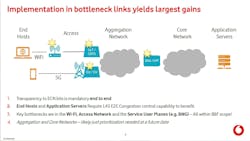L4S: Powering our interactive applications in the home
Jonathan Newton / Vodafone and Broadband Forum
When end-users are gaming or on a video call, the last thing they want is a laggy application experience. Lag can be caused by many things, but network delay (latency) of 100ms or more, like the blink of an eye, can contribute to a noticeable lag in sensitive applications and lead to a poor perception of the broadband service.
In short, the broadband industry is in a period of transition. Left behind is the dilemma of how to outpace the competition with business models that focus purely on bandwidth and cost. That viewpoint is long outdated. Broadband Service Providers (BSPs) are increasingly providing services that are designed to help applications deliver a consistent end-user experience, with a key focus on the impact of latency.
At the same time, latency is gradually being recognized by end-users as a key indicator of broadband performance, instead of focusing on the speed test. There are considerable benefits of lower latency for the video streamer, video conference user, or perhaps most applicably, the online gamer. In turn, network quality of experience is starting to emerge as a critical selling point for the BSP.
What is the fuss about low latency?
Even those in the same household and sharing the same network connection may judge the network quality differently, depending on the application in use. Some types of applications, such as internet browsing or messaging apps, can handle a connection with high or varying latency without the user even noticing. Whereas, for those users watching a live video broadcast or using an interactive streaming application, especially in virtual reality, even the smallest variation in network latency may be noticed. Those in the cloud gaming space are especially interested in ways to experience low latency and no lag, which is critical to delivering a fully immersive and smooth experience.
This need for low and stable latency even under congestion, when the end user is fully utilising their broadband service, is increasingly important for many interactive home applications, and this is expected to increase as services such as extended reality (XR) streaming, as well as cloud gaming, become more prevalent.
L4S: What does it mean?
Discussions around the technical feasibility of delivering lower latency and identifying potential solutions for this real-world problem are well underway. Low Latency, Low Loss and Scalable Throughput (L4S) technology, defined by the Internet Engineering Task Force (IETF) in 2023, is designed to support both low latency, low loss, and high throughput simultaneously.
Offering the potential to enable more responsive and reliable services, the beauty of L4S is that it enables the latency-sensitive applications and the network to work together to almost eliminate queueing delays (a key source of latency) for application data packets passing over an L4S-enabled network. These queueing delays occur when internet packets must wait in buffers across the network, in routers and modems, for example, before being sent to their destinations. These buffers are essential to how the internet works and are critical for a lot of classic (non-latency-sensitive) applications to be provided with the best possible throughput, so whilst they cannot be removed, L4S ensures they are used as little as possible.
With L4S, an application indicates to the network that it is latency-sensitive by marking its packets with a specific indicator. The L4S-enabled network then provides early and detailed feedback to all L4S applications about the status of the network queues, especially if any network queue starts to build up. This feedback, conveyed by the network marking packets as “congestion experienced,” allows the sending application’s L4S-compliant congestion control algorithm to prevent queue growth. This partnership between applications and network works consistently regardless of the volume of traffic and can be implemented over any access technology (wireless or wireline).
L4S can provide benefits to any latency-sensitive application for home and enterprise users, including gaming, remote desktop, connected autonomous vehicles/drones, and smart factories. It also minimises loss, which results in fewer glitches and retransmissions by the application.
Introducing L4S to broadband networks
The Broadband Forum has a key focus on Quality of Experience, and this includes specifying how the IETF’s L4S specification can be applied to a broadband network. The Application of L4S to Broadband Networks project is defining how BSPs can introduce the technology and undertake phased implementations into their own networks.
L4S does not need to be implemented across the entire network to unlock the main benefits, allowing certain parts of the network to be focused on first before the focus turns to providing full end-to-end support. This approach will help to enable the deployment of L4S technologies earlier than would be possible if all elements of a network were required to support it right from the start.
It is worth remembering that L4S only works when both the application and the network support it, so early implementation in broadband networks will help the L4S ecosystem to grow.
Industry innovation
Trials have been underway in recent years demonstrating how L4S can support multiple users over the same connection when using an interactive application, without sacrificing performance. Vodafone and Nokia have successfully trialled L4S on a live commercial fibre broadband network in Istanbul, with the two companies reducing lag by up to 94%.
L4S has also been applied in DOCSIS networks – as specified by CableLabs – known as ‘Low Latency DOCSIS (LLD)’. CableLabs’ efforts have highlighted how low-latency applications can be consumed over broadband networks without affecting the quality of unmarked traffic. It separates queue-building traffic, such as a file upload, from non-queue-building traffic, such as an online gaming session.
Some cable operators, such as Comcast, are also rolling this out to several US cities following successful trials alongside the likes of Apple, NVIDIA, and Valve.
Standards offer a building block
There are several different standards development organizations, including Broadband Forum, IETF, WBA, IEEE, CableLabs and 3GPP, working on delivering low and consistent latency across different network technologies. Every organization is playing a key role in delivering L4S capability end-to-end, with the Broadband Forum providing clear architectural guidance and requirements for broadband networks to support L4S. Our joint efforts have the primary aim of giving customers a more responsive and reliable broadband service unhindered by lag, with L4S set to enable a more interactive internet experience.
L4S will ensure real-time applications, from XR to remotely controlled drones, are not hampered by high latency, and significant queuing delays are not experienced. As L4S trials and real-world implementations and deployments continue to ramp up, there is clearly an appetite for low and stable latency in our current and future broadband networks.
With demand for low-latency, high-performance applications growing, collaboration between Broadband Service Providers, application developers, and standards bodies is essential. The Broadband Forum’s L4S project offers an important opportunity to contribute to the evolution of broadband networks and ensure they are ready to support the next generation of interactive services.
Jon Newton is a Vodafone Distinguished Technical Expert, shaping strategy, innovation, and best practice in fixed broadband technologies. He is co-director of the Broadband Forum’s Network Architecture Work Area and has over 25 years’ experience in the architecture, design, and performance management of large-scale international communications networks.


